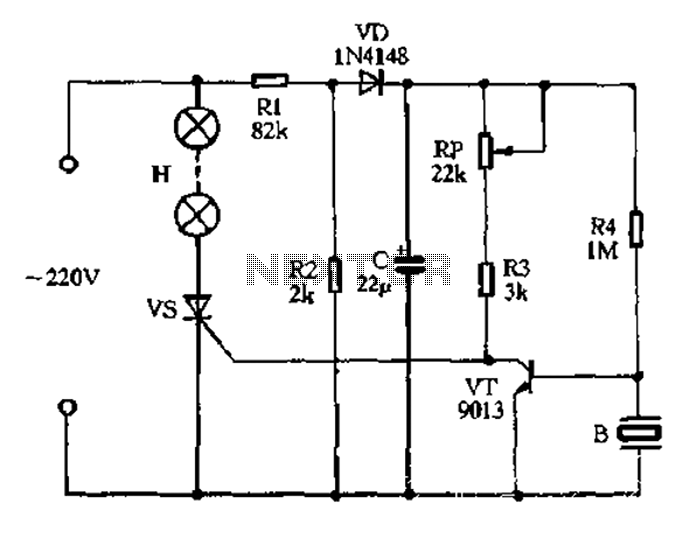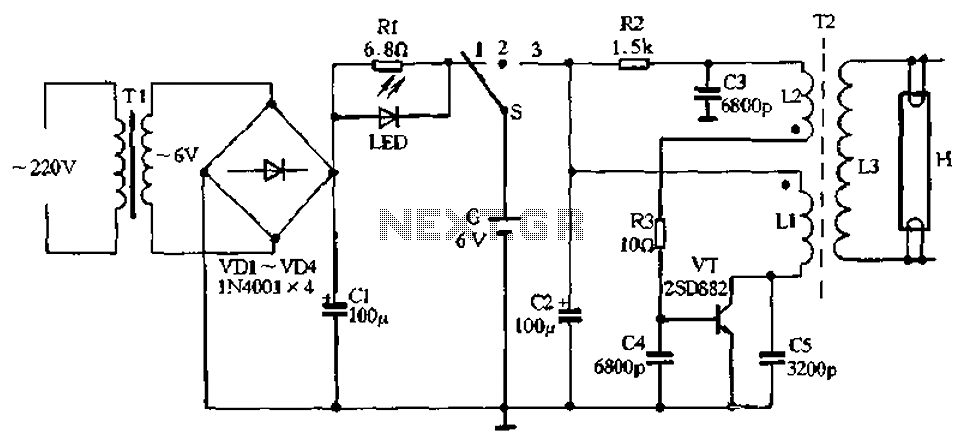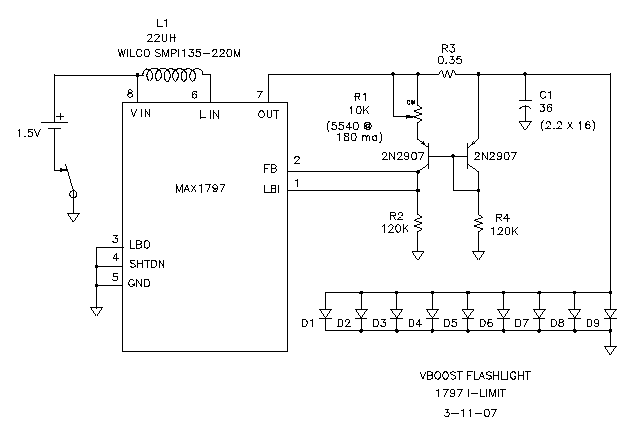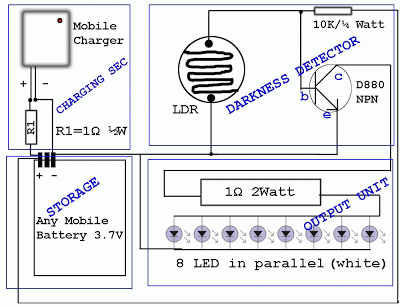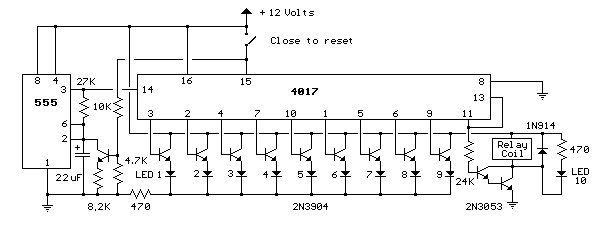
Fairy Flashing LED Lights
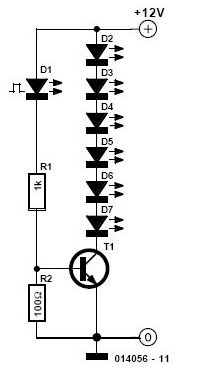
This simple and inexpensive circuit is not limited to Christmas. It consists of two resistors, a small-signal transistor such as a BC547, one flashing LED, and a string of standard LEDs. The flashing LED functions as an oscillator, turning the transistor on and off; in turn, the transistor controls the operation of all the other LEDs. An unregulated 12 V mains supply can be used for power. No current-limiting resistor is necessary in the LED chain, as the forward voltages of the LEDs in the chain sum up to the supply voltage. For instance, if red LEDs with a voltage drop of 1.65 V are utilized, the 12 V supply can power seven of them; alternatively, six yellow LEDs (2.1 V each) or five green LEDs (2.7 V each) can be used. Mixing different colors is also an option. Additionally, a PNP transistor can be included alongside the NPN transistor, with its emitter connected to +12 V and another string of LEDs connected to ground. This configuration allows the two strings to flash alternately.
The circuit operates on a straightforward principle where the flashing LED acts as a pulse generator, creating a square wave signal that drives the base of the NPN transistor. This type of transistor is commonly used in low-power applications and is ideal for switching operations. The resistors in the circuit serve to limit the base current to the NPN transistor, ensuring that it operates within safe parameters while being driven by the oscillating signal from the flashing LED.
When the NPN transistor is turned on, it allows current to flow through the connected string of LEDs, illuminating them. The forward voltage drop across each LED must be considered to ensure that the total voltage drop does not exceed the supply voltage. The alternating flashing effect can be achieved by adding a PNP transistor, which is configured to turn on when the NPN transistor is off, thus creating a complementary flashing pattern between the two LED strings.
In terms of power supply, the use of an unregulated 12 V source is suitable for this circuit, but care must be taken to ensure that the supply voltage does not exceed the maximum ratings of the components used. The absence of a current-limiting resistor in the LED chain simplifies the design, but it requires precise matching of the forward voltage characteristics of the LEDs to avoid overcurrent conditions.
Overall, this circuit provides a versatile and engaging way to create visual effects using LEDs, suitable for various applications beyond just holiday decorations. By experimenting with different LED colors and configurations, users can customize the flashing patterns to suit their preferences, making it a fun and educational project for electronics enthusiasts.This simple and cheap circuit is not just for Christmas! There are just two resistors, a small-signal transistor such as a BC547, one flashing` LED and a string of normal` LEDs. The flashing LED works as an oscillator and switches the transistor on and off; and the transistor switches all the other LEDs.
An (unregulated) 12 V mains supply can be u sed for power. No current-limiting resistor is required in the LED chain, because the forward voltages of the LEDs in the chain add up to the supply voltage. If red LEDs are used, with a voltage drop of 1. 65 V, then 12 V will supply seven; alternatively, use six yellow (2. 1 V each) or five green (2. 7 V). You can of course always mix the colours. Alongside the NPN transistor add a PNP transistor with its emitter connected to +12 V, with another string of LEDs connected down to ground.
The two strings will flash alternately. Be the first of your friends to get free diy electronics projects, circuits diagrams, hacks, mods, gadgets & gizmo automatically each time we publish. Your email address & privacy are safe with us ! 🔗 External reference
The circuit operates on a straightforward principle where the flashing LED acts as a pulse generator, creating a square wave signal that drives the base of the NPN transistor. This type of transistor is commonly used in low-power applications and is ideal for switching operations. The resistors in the circuit serve to limit the base current to the NPN transistor, ensuring that it operates within safe parameters while being driven by the oscillating signal from the flashing LED.
When the NPN transistor is turned on, it allows current to flow through the connected string of LEDs, illuminating them. The forward voltage drop across each LED must be considered to ensure that the total voltage drop does not exceed the supply voltage. The alternating flashing effect can be achieved by adding a PNP transistor, which is configured to turn on when the NPN transistor is off, thus creating a complementary flashing pattern between the two LED strings.
In terms of power supply, the use of an unregulated 12 V source is suitable for this circuit, but care must be taken to ensure that the supply voltage does not exceed the maximum ratings of the components used. The absence of a current-limiting resistor in the LED chain simplifies the design, but it requires precise matching of the forward voltage characteristics of the LEDs to avoid overcurrent conditions.
Overall, this circuit provides a versatile and engaging way to create visual effects using LEDs, suitable for various applications beyond just holiday decorations. By experimenting with different LED colors and configurations, users can customize the flashing patterns to suit their preferences, making it a fun and educational project for electronics enthusiasts.This simple and cheap circuit is not just for Christmas! There are just two resistors, a small-signal transistor such as a BC547, one flashing` LED and a string of normal` LEDs. The flashing LED works as an oscillator and switches the transistor on and off; and the transistor switches all the other LEDs.
An (unregulated) 12 V mains supply can be u sed for power. No current-limiting resistor is required in the LED chain, because the forward voltages of the LEDs in the chain add up to the supply voltage. If red LEDs are used, with a voltage drop of 1. 65 V, then 12 V will supply seven; alternatively, use six yellow (2. 1 V each) or five green (2. 7 V). You can of course always mix the colours. Alongside the NPN transistor add a PNP transistor with its emitter connected to +12 V, with another string of LEDs connected down to ground.
The two strings will flash alternately. Be the first of your friends to get free diy electronics projects, circuits diagrams, hacks, mods, gadgets & gizmo automatically each time we publish. Your email address & privacy are safe with us ! 🔗 External reference
